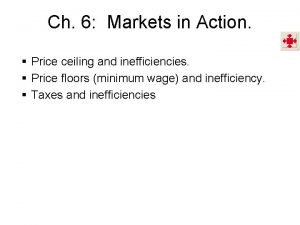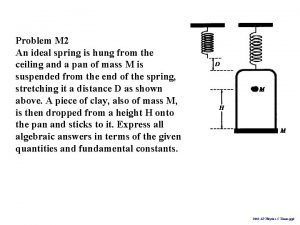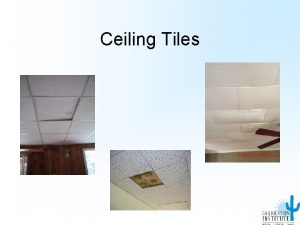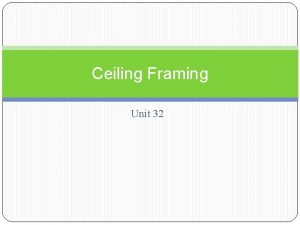Design elements and country experiences II ceiling prices














- Slides: 14

Design elements and country experiences II: ceiling prices, financial guarantees, and penalties July 17, 2019 1

Ceiling prices control costs and generate market signals, but setting is a challenge No ceiling price vs. with ceiling price • Control over maximum costs • Create price signal for market Successful bids Price in Cent/k. Wh Ceiling prices: relevance and Relevance: calculation Unsuccessful bids Disadvantage: • Too high could signal lack of competition. • Too low could crowd-out competition. India: Developers deemed $3. 89* ct/k. Wh unrealistic in hybrid procurement. • Ceiling difficult to set if little information Ceiling price (e. g. LCOE-based) Defined volume Volume in MW Calculation: • LCOE + producer rent • If applicable: previous feed-in tariff • Cash-flow model analysis (*1 USD = 69. 3510 Indian Rupees) • Adapt based on experience 2

How to calculate the levelized cost of electricity (LCOE)? What does the LCOE tell us? Revenue needed to cover total costs of building and operating a power plant over its life. Calculated over 20 years Expressed in units of currency per k. Wh Net present value time value of money through discount rate. Discount rate weighted average cost of capital (WACC) 3

Levelized cost of energy (LCOE) Net present value of project lifetime costs Upfront investment cost (e. g. $1, 446. 34/k. W wind in Brazil 2015) O&M: O&M contract, land leases, insurance (e. g. $39. 87/k. W wind in Brazil 2015) Net present value of project lifetime generation Plant capacity * full-load hours (8760 * capacity factor, e. g. 47. 5% wind in Brazil 2015) – loss in quality/line losses Ceiling price: LCOE + margin 12/3/2020 ©Abt Associates 4

Most countries disclose ceiling prices Disclosing ceiling price Benefits: • Helps prevent projects from being rejected in the auction. • Gives bidders more planning security (sunk costs). Disadvantages: • Bids close to ceiling price if low competition Price in Cent/k. Wh Ceiling price (e. g. LCOE-based) Country examples Defined volume Successful bids Unsuccessful bids Volume in MW Undisclosed ceiling price • South Africa, Peru (rounds 1 -3) Disclosed ceiling price • Brazil (combined with undisclosed auction volume), Mexico, India, Peru (round 4) 5

Auction procedure: ceiling prices Interactive Session • Assume a ceiling price of USD 7 cent/k. Wh (ceiling price chosen arbitrarily) • Have a look at the assignment sheet – you will find project costs assigned to you. • Given this information, note down the bid you are willing to make • Static sealed bid auction – all bidders hand in their bids at the same time • Announcement and quick evaluation of the results. 6

Financial guarantees: considerations and country examples Considerations Country examples Ethiopia (government-sited, 100 MW) • Bid bond: $3/k. W • Completion bond: $15/k. W Zambia (government-sited, 2 x 50 MW) • Bid bond: $26/k. W – Balance with technical requirements and consider and • Completion bond: $300/k. W ($15 M per risks. project) South Africa (bidder-sited) • Splitting financial guarantees between commitment (bid bond) • Bid bond: $8/k. W and completion (project • Completion bond: $16/k. W completion) helps: Brazil (bidder-sited) – Seriousness of bid according to • Bid bond: 1% of investment cost • Completion bond: 5% of investment milestones cost – Balancing burden on bidders. • Sufficiently high financial guarantees help ensure seriousness of bid and project completion 7

Penalties enforce project realization Planning Approval process Considerations • Penalties imposed in case project is delayed or fails to comply with the requirements stated in the PPA contract. • Examples of penalties: – Execution of financial guarantees if: • Signing of PPA is delayed • Project delays or cancellation – Cancellation of the PPA – Exclusion of bidder and/or project Construction Operation No/delayed realization Deadlines and penalties + Incentive to realize due to penalties - Risk for bidders increases - Prohibitive barrier for (some) bidders Country examples • Zambia: termination of PPA if longstop deadline missed. • South Africa: Reduction of PPA duration by 2 days/1 day of delay. Termination of PPA if deadline missed > 180 days. 8

Example: setting financial guarantees (1/II) How to 1. Define level as a percentage of total investment costs calculate • International examples show: 1 -2% for the bid bond, 5 -7% for them? the completion bond • Assume installation costs of $1671/k. W for utility scale solar PV 2. What is the value range for the bid bond? $16. 71 - $33. 42/k. W 3. What is the value range for the completion bond? $83. 55 $116. 97/k. W 4. Calibrate your ranges: • Bid bond: consider the permits and approvals to balance burden on bidders (remember: avoid too high sunk cost!) • Completion bond: consider the savings potential in e. g. module price reductions delaying project construction enables

Example: setting financial guarantees (1 I/II) When to apply them? Bid bond • Submitted with the bid, returned after the Power-Purchase. Agreement (PPA) is signed • For non-awarded projects the bid bond should be returned directly after the auction Completion guarantee: • Submitted with the signature of the PPA • Returned once the project is commissioned

Conditions for participation: financial guarantees 11

Example: setting penalties (1/III) How to calculate them? 1. Calibrate your penalty • Assume installation costs of $1671/k. W for utility scale solar PV, and completion bond of 5 -7% • Assume penalty is applied during year 1 after realization deadline • What is the penalty at 5%? $83. 55/k. W • What is the penalty at 7%? $116. 97/k. W 2. Consider: Incentive to pay the penalty given yearly module price reduction Savings = $1671/k. W x % share module costs on total project costs x (1 – % module price reduction after 1 year) Careful: Calculation is a simplification! Savings = $1671/k. W x 0. 385 ($644. 5/$1671) x 0. 74 (1 - 0. 26) Savings = $476. 1 = higher than penalty In theory, incentive to delay by 1 year

Example: setting penalties (1 I/III) Caveats Savings assume that past module decrease will continue over a year: e. g. between Dec. 2016 and Dec. 2017, crystalline silicon module price decline of 1% - 7% In practice, bidders might avoid delay: the prospect of saving in project costs vs. risk of losing the PPA.

Example: setting penalties (1 II/III) When to apply them? • Penalties are to be executed in case of delays in the commissioning of the project. • The penalty should execute the completion bond, e. g. $83. 55/k. W $116. 97/k. W • Consider escalation of the penalty over time, e. g. over a 12 -month delay period. Realization deadline • Ex. : 1/12 of the penalty per month of delay. 2 years • PPA cancellation in case of severe delays (e. g. of more than a year) No delays Construction Delay up to 1 year Construction Delay > 1 year Construction Operation
 Host country and home country
Host country and home country Intra country vs inter country
Intra country vs inter country Steel truss plan
Steel truss plan Elements and principles of interior design ppt
Elements and principles of interior design ppt Producer
Producer Ordering woodcock johnson iv
Ordering woodcock johnson iv Floor and ceiling discrete math
Floor and ceiling discrete math Binding price floor
Binding price floor Vineland basal and ceiling rules
Vineland basal and ceiling rules Gfta-3 protocols
Gfta-3 protocols Finishing interior walls
Finishing interior walls A spring is hung from the ceiling
A spring is hung from the ceiling Chapter 6 prices and decision making assessment answers
Chapter 6 prices and decision making assessment answers The pricing tripod
The pricing tripod Chapter 6 demand supply and prices
Chapter 6 demand supply and prices



























